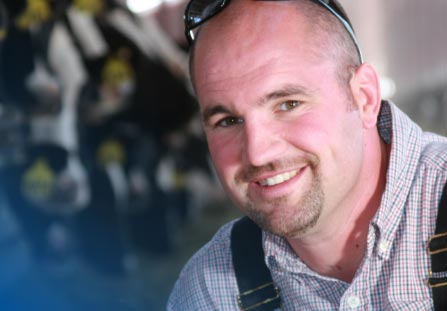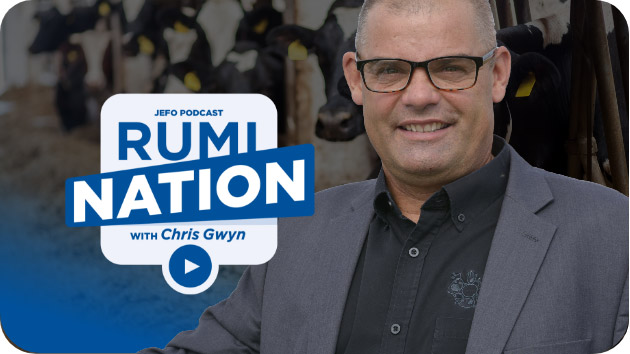Did you enjoy this episode?
Share now!
Our guest - Doug DeGroff
Doug DeGroff earned his bachelor’s degree from Cornell University in Dairy Science in 1996. While at Cornell, he was a member of the Dairy Fellows program as well as the Farm Credit Fellows program. After graduation, he entered the dairy industry in sales and marketing with Monsanto Company. Later, he spent a year managing a large dairy outside Green Bay WI. Then in 2002, he started with Cargill Animal Nutrition as a dairy nutritionist.
In 2007, Doug started his own company; Diversified Dairy Solutions, LLC; A dairy nutrition and management-consulting firm.

Timestamps & Summary
Chris Gwyn (04:01)
Why the advocacy for safety related to silage management has become so important to you, both personally and professionally?
Doug DeGroff
It’s because I’m a silage avalanche survivor that it’s near and dear to my heart. I was young and quite confident and with an attitude of “it can’t happen to me.” But my luck ran out on August 27, 2009, while taking a solid sample that I’d done thousands of times […]
Chris Gwyn (08:32)
What are some of the key points in the silage safety that you feel are extremely important to share?
Doug DeGroff
I think the first thing I’d like to say it can happen to you or it could happen to your dairy or your feedlot. […]
Once you know that, then you have to be intentional about it. If you’re a dairy owner or a feedlot owner, you have an obligation to those people who work on your business, whether they’re a full-time employee, a contract employee, maybe a silage harvester or your nutritionist or feed salespeople. […]
If somebody gets seriously hurt or tragically killed, it’s very bad for your business financially. So training, talking to your employees, talking to these people that are going to be around your silage piles, hanging up, putting up signs, there’s so much you can do. And either you have a good silage safety management program, or you make excuses when somebody gets injured or killed. It’s one or the other. You really don’t have both.
Chris Gwyn (11:53)
What would you define as a good silage safety program?
Doug DeGroff
It starts with sitting down with the employees and going over the risks […] with anybody who’s going to be in the feed area. And not just the risk of it avalanching. There are other risks with silage. There are gases, there’s equipment driving around it all the time. […]
Have some standard operating protocols at the time of harvest. […]
When you have new employees, make sure you don’t wait until the next training session. They should have a course of what’s going on within days of being hired. […]
Chris Gwyn (14:43)
What should employees working around silage management be thinking and what do they need to do differently?
Doug DeGroff
Certain employees are there in front of piles every single day, multiple times a day. They’re the people with the highest risk because they have the highest exposure. So, they need to be aware of what could be happening when they’re going up, removing tires or removing plastic. It comes pretty good, if the owners haven’t done it, if an employee is asking: “Hey, can you get me a safety harness?”, “Can you get a cable that runs across the length of the pile?” […]
I won’t recommend you pitch off bad feet anymore because God forbid somebody gets hurt. I’m the person who made the recommendation. I used to do that. I no longer do that. And I don’t support that. […]
Chris Gwyn (18:58)
What’s your recommendation for safely sampling silage on dairies on feedlots?
Doug DeGroff
I’ll start off with what I used to do and why I did it. And then, I’ll tell you how stupid of an idea it was.
I liked to sample the pile up and down. So, I would get in the loader of the bucket, and I would go up and down. I get to the top of the feed because that feed is different than this feed down here. And if I went straight down the middle of the pile, I would get arguably a very good representation of the pile. […] I had a five-gallon bucket and I put so many handfuls in every foot to eighteen inches and I mixed that feed up and then I put it in my bag, and I had an incredibly good representation of the pile.
It was probably about as unsafe as you can get because at the bottom, the loader backs away because now I can get it. So, I’’m standing there for a few minutes, as much as I can reach, high and low. […]
Now, all my dairies, they know exactly what to do. They’ll either face it with a facer or they’ll scrape it with a payloader and knock it and then what they’ll mix it up, spit it out. Then we put another five thousand pounds in it, mix it up, spit it out in a safe place. I would argue that is the best representation of the pile. […]
Chris Gwyn (23:24)
Key points that you feel are important when it comes to safety around silage management.
Doug DeGroff
The most important part of any solid safety program or any silage program is safety. […]
We don’t spend enough time on safety until something happens. […]
But there’s nothing real sexy about safety, but it’s so necessary. And we just have to keep that in mind. […]






